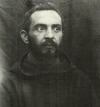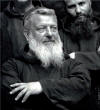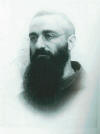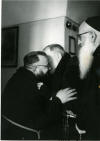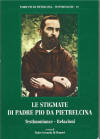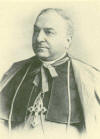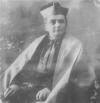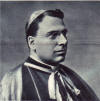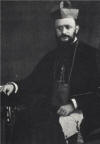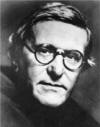6 Medical and ecclesiastical examinations
Summary:
Padre Benedetto and Dr. Merla; Drs. Romanelli, Bignami, and Festa; Padre
Pietro da Ischitella, Dr. Cardone: Silj, Gasparri, Costa, Kenealy,
Cerretti, Poli, Besi, Bastianelli, Valbonesi, Nove. Padre Gemelli.
Padre Pio
Padre Benedetto
Padre Benedetto da San Marco in Lamis
On March 3, 1919 Padre Benedetto, provincial minister of the Capuchins,
examined Padre Pio’s wounds and
sent a letter to Padre Agostino: “They are real wounds, perforating the
hands and feet. I have also observed the side wound: it is a real gash
that bleeds continuously either blood or serum.”[1]
On April 24, 1919 Padre Benedetto informs the Padre Generale in Rome,
explaining what he had seen, and that he had not informed him before,
because of the sensitivity of the issue.[2]
The friars had no idea if the wound could be infected or contagious,
since Padre Pio had been diagnosed in the past as probably having
tuberculosis. And the Spanish fever was still raging or. An answer could
come only from doctors.[3]
On May 1, 1919 Dr. Angelo Maria Merla was the first doctor to see Padre Pio after he received the wounds. He was the doctor of the friars, and also the mayor of San Giovanni Rotondo.
Dr. Merla went to the convent by request of Padre Paolino di Tomaso da Casacalenda, the Superior of the Convent. The request was not for a formal examination, but to exclude any possible contagiousness or harm to Padre Pio’s health, given that the Spanish fever was still raging. Besides, there was still a suspect that Padre Pio might have tuberculosis.
Dr. Merla was an atheist and not
interested in things outside the natural. He didn’t make a written
report. He informed De Fabritiis, the Prefect of Foggia, that in his
opinion the lesions were not the result of tuberculosis, but that he
could not say with any certainty what caused them, and could not exclude
that they might have been artificially inflicted.[4]
[5]
Dr. Romanelli
Dr. Luigi Romanelli was the first doctor to perform a formal examination of the wounds, by disposition of Padre Benedetto di San Marco in Lamis, Provincial Superior of the Capuchins in Foggia.
Romanelli was the head
surgeon of the civilian hospital in Barletta. Dr. Romanelli visited
padre Pio for the first time on May 15 and 16, 1919. He performed four
follow up examinations. The last was in July 1920.
Dr. Romanelli wrote a report to Padre Benedetto, and he forwarded it to the Superior General of the
Capuchin Order in Rome.[6]
The report starts noting that Padre Pio appears “frail, pale, and
malnourished”; and continues:
"The lesions on the palm of both hands, at the level of the 3rd metacarpal bone, and the size of a five cents bronze coin (about 1 ½ inches) for the right hand, and of two cents (about 1 inch) for the left hand, are covered by a red brown elastic membrane, without bleeding, no edema and no inflammation of the surrounding tissues.
The shape is
almost circular. The surrounding tissues are intact and normal.
The pigmented areas are membranes covering a hole. There is no bone
resistance.
The skin in the dorsal area of both hands presents similar features.
I am certain that these wounds are not superficial because, putting my
thumb in the palm of the hand, and the index finger on the back, and
applying pressure on the membranes, I have the exact perception of a
void existing. Those membranes are covering a hole that starts in one
side, and ends in the other side. The pressure on the membranes causes
intense pain"
[7]
“The wounds on the feet are circular, with a diameter of a five cents
coin (about 1 ½ inches),
covered with red lucent membranes, with sharp edges and surrounded by
normal tissue. They are located in the area of the second metatarsal
bone. The palpation of the membrane gives the impression of a void under
it. The plantar lesions have the same characteristics. Pressing
simultaneously on both membranes appears clear that there is a void, and
that the foot is perforated and covered by the membranes”[8]
“In the hands and in the feet all the movements of the joints and of the
fingers are normal, and don’t give any inconvenience.”[9]
“On the left side of the chest, in the area of the sixth intercostal
space, there is a linear slash wound of about seven centimeters
(about three inches), leaking
out arterial blood. It is difficult to assess the depth. It is a cut
wound”[10]
“In my opinion the wounds are not originated by infection because there
is no inflammation. They are not originated by trauma, because it would
be absurd that a trauma damages the deep tissues without damaging first
the superficial tissue.”
“I know that have been described cases of auto lesions secondary to
morbidity of the nervous system, but still they would not be able to
produce lesions of the deep tissues without damaging the superficial
tissues.”
“I have observed Padre Pio for several months, and the lesions are still
the same, and what is more astonishing, they do not produce limitation
and malfunction of the articulations, like the normal wound do.”
"The etiology of the lesions of Padre Pio is not natural.
The agent producing those lesions needs to be searched, make no
mistakes, in the supernatural.
The fact in itself it's a phenomenon that cannot be explained with the
sole human science."[11]
[12]
[13]
July 1919: Dr. Amico Bignami, professor of medical pathology of the
University of Rome, an atheist, examined Padre Pio by disposition of
Padre Venanzio da Lisle, Superior General, and of Padre Giuseppe da
Persiceto, General Procurator of the Capuchin Order.
On July 26, 1919 he gave a written report of his examination.
The report starts stating that Padre Pio “has delicate constitution, a
pale complexion, underdeveloped muscles, sickly suffering appearance,
and flabby gait.”
And continues:
“His attitude, modest and humble, the tall and serene forehead, the
expression of his face full of goodness and sincerity, inspire sympathy.
However there is nothing particularly attractive in his way of talking.”
“The physical exam shows “normal heart, a bit elevated resting pulse of
90; normal respiration except for some respiratory weakness on the apex
of the right lung; liver and spleen are normal. Urinalysis has not been
done.”
“He sleeps well and doesn’t dream.”
“Nervous system: diffuse cutaneous hyperesthesia, more relevant in the
left side of the chest, and around the heart, and in the palm and back
of the hands and feet.”
“There is an evident dermographism in the thoracic area and in the
back.”
“Padre Pio reports that he has never suffered of a nervous illness, and
never had experienced fainting, convulsions, or tremors.”
“Despite the apparent frailness, he is able to hear confessions fifteen
or sixteen hours straight without a bite to eat. He eats very little,
mostly vegetables.
On the palm of the right hand there is a thin round blackish scab,
detached from the underlying skin, with sharp edges. The surrounding
skin in normal, and has a small halo intensely colored by iodine. The
area of the scab and the surrounding skin are painfully pressure
sensitive. A similar scab is observed on the corresponding site of the
back of the hand, at the level of the 3rd and 4th
metacarpals. This scab and the surrounding skin are also strongly
colored by iodine.
There are similar, perfectly symmetrical lesions on the left hand.
With proper palpation, normal metacarpal bones are felt.
There is evident hyperesthesia of the skin and of the muscles to
palpation.
On the dorsal side of the right foot, in correspondence of the 2nd
metatarsus, there is a little dark and round very superficial scab,
intensely colored with the surrounding skin, with iodine. On the plantar
side, there is a little round area, without alteration, strongly tinted
with iodine. On the right foot the alterations are identical and
perfectly symmetrical; there is hyperesthesia on the dorsal and plantar
sides of the feet.
There is no inflammation of the skin surrounding the above described
lesions that can be recognized by eye inspection and palpation.
On the left side of the chest, there is a shape of a cross, with the
left arm slanting from the fifth to the ninth rib.
The short arm is half the size. The skin is dry, similar to
superficial abrasions, and intensely colored with iodine. The skin is
not infiltrated, is very sensitive to touch and is not bleeding during
the examination. The lesion does not deepen in any point, and derma is
not damaged. In the whole chest area there is evident superficial
hyperesthesia.
“Questioned repeatedly about the origin of the lesions, Padre Pio
answers that they formed all al the same time, the past September. It
seems that they started with local pain and with the discharge of few
drops of blood; then appeared the brown membranes that from time to time
detach; and when this happens – Padre Pio reports – under the detached
scab there is a similar one, already formed. Sometimes those lesions
bleed”
When these lesions formed, Padre Pio did not have any other somatic
symptom that would get his attention. However, this information cannot
be held as totally accurate, because Padre Pio confesses that he did not
pay much attention to the succession of the events, and to their
evolution.”
“Asked why he applies iodine, Padre Pio states that he uses it as a
disinfectant a couple of times per week or more often; and also
states that if he doesn’t apply it,
the lesions bleed easily. It
turns out that he uses the same iodine since last September, and that
makes it old iodine.
Questioned why he puts iodine on a small round area on the plantar side
of the foot, were there isn’t any cutaneous lesion, he states that at
times that area bleeds, and he applies iodine on it.”
"About the nature of the described lesions it can be asserted that they
are a pathological product, on the origin of which, the following
hypotheses are possible:
a)
They might have been artificially and voluntarily produced;
b)
They might be the outcome of a morbid state;
c)
They might be in part the outcome of a morbid state, and in part
artificial.
I definitely can’t support the first hypothesis, especially lacking a
direct proof…. The impression of
sincerity that Padre Pio gives me, keeps me definitively from thinking
of simulation.
The second hypothesis is, at least partially, reliable. The pathologists
know about the “multiple neurotic necrosis of the skin” and the “hemato
hydrosis” in the recent book of Cassirer, and in many other works.
The alterations in the hands of Padre Pio are nothing else that the
result of a superficial necrosis of the epidermis, and maybe of the more
external parts of the derma, and can be classified with the above
mentioned neurotic necrosis.
What cannot be explained by what we know about the neurotic necrosis is
the perfectly symmetrical localization of the described lesions, and
their persistence without noticeable changes, as the patient states.
But these facts, in my opinion, can have a satisfactory explanation with
the third above mentioned hypothesis. In fact we can assume that the
lesions started as a pathological product (multiple neurotic necrosis of
the skin), than, maybe unconsciously and by suggestion, completed in
their symmetry and kept artificially by chemical means, such the iodine.
I have already mentioned that on the plantar side of the foot there is
no necrobiotic change of the skin, but only a brown pigmentation due to
iodine applied to the area corresponding to the extremely superficial
lesions.
It is known that old iodine, develops iodhydric acid, and becomes
strongly irritant and caustic (and this is not well known lo Ly people,
and perhaps not known even by some doctors). It appears logical that
applying the same iodine for several months might have made more
intensive previous cutaneous alterations, and might have produced others
in normal tissues.
This seems to me the more reliable interpretation of the facts I have
observed. At any rate it can be stated that there is nothing in the
described alterations of the skin that can’t be the product of a morbid
state and of the action of known chemical agents.
"The lesions on the hands, feet and side can be explained as
unconsciously self-produced by autosuggestion, and kept artificially
with repeated applications of tincture of iodine." He also stated: “I do
not understand how these wounds have persisted for nearly a year now
without getting better or worse.” Bignami also commented:
“The expression of Padre Pio’s face is full of goodness and sincerity
and leads me to the positive exclusion of a simulation”.[14]
[15]
Sealing
Bignami was confident that the wounds, left untouched, without using any
kind of medication, after eight days would heal.”[16]
He ordered the wounds wrapped in new bandages, and sealed every day for eight days, under supervision of a sworn committee. When the bandages were unsealed and removed eight days later “the wounds remained the
The committee was composed of Padre Paolino da Casacalenda, Padre
Basilio da Mirabello Sannitico, and Padre Ludovico da San Marco in
Lamis.
[20]
Padre Paolino wrote: “I am particularly grateful to Dr. Bignami. Without his order I would never had a chance to see the wounds. I was particularly impressed by the side wound. It has almost a form of an X. That means that
they are two wounds.”[21]
Dr. Festa
On October 9 and 10, 1919, Dr. Giorgio Festa, a surgeon in private
practice, well known in Rome at the time, examined the wounds by
disposition of Padre Venanzio da Lysle, Superior General of the Capuchin
Order.
He made three examinations. The last was in 1925.[23]
[24]
On October 28, 1919, Dr. Festa, back in Rome, wrote a report of his
examination, and gave it to the superior general of the Capuchin order.
“In the palm of the left hand there is a circular lesion a little less
than 1" in diameter. The lesion has a red brown color and is covered
by a blackish crust. The lesion doesn’t seem very deep. The back of the
left hand has a lesion similar to the one on the palm. The lesions on
the right hand have the same characteristics of the left hand.
The dorsal and plantar sides of the feet have circular lesions similar
to the ones on the hands. Applying a light pressure on the lesions
elicits a sharp pain. While examining the lesions ooze serum and blood.
The skin surrounding the lesions shows no signs of edema, infiltrate, or
inflammatory reaction.
Le lesion on the left side of the chest, transversal, about two fingers
below the nipple, has the form of a cross, with the long arm measuring
about little less than three inches, and the short arm about 1 ½ inches.
The lesion is superficial and still emits drops of blood, more than the
other lesion.
The lesions appeared all together on September 1918, 13 months ago, and
show the same freshness as they had just appeared. In all this months
they have not shown any tendency to cicatrization.
My opinion is that they were not originated by a cutting object or by
applying chemical substances. The action of chemicals would have
influenced also the surrounding tissues, which are normal. Padre Pio has
applied iodine every couple of days to limit the loss of blood. However
he hasn’t applied any for more than 3 months, by disposition of his
superiors, and the lesions present the same characteristics as before.
My conclusion is that the lesions and the hemorrhage of blood have an
origin that our knowledge is very far from explaining.
The reason for them is well above the human science.”[25]
[26]
Padre Pietro da Ischitella
Padre Pietro da Ischitella
About the depth of the lesions, dr. Festa wrote that Padre Pietro da
Ischitella, the provincial superior had observed the lesions few months
after the event and had clearly the impression that the lesions went
through the whole hand. Dr. Festa continued: “I have personally
questioned Padre Pietro da Ischitella, and he told me verbatim: ’If a
superior authority asks me I can declare and confirm swearing that
looking at the wound from the palm side one can easily see through,
recognizing a writing or an object positioned on the other side.’ “[27]
Dr. Andrea Cardone
Dr. Andrea Cardone
Dr. Andrea Cardone from Pietrelcina, who was friend and physician of
Padre Pio for many years, testified in 1968: “In both hands exist holes
a bit larger than half inch, passing through the palm of the hands to
the other side; so that one could see light passing through. And with
pressure the fingertips of my thumb and pointer touched each other.”[28]
In July 1920 the professors
Giorgio Festa and Luigi Romanelli
did follow up examinations of the wounds.
They did not perceive any interruption in the bones of the hands and of
the feet.[29]
Reported by Dr. Festa: A colleague of mine asked Padre Pio : "Why the
lesions are here and not in other parts of the body?" Answer: "You are a
doctor. You should tell me why they should have been in other parts of
the body and not here."[30]
[31]
[32]
The colleague of dr. Festa was dr. Bignami.[33]
[34]
Dr. Alberto Caserta of Foggia did x-rays of the hands of Padre Pio on
October 13, 1954. The radiographs did not show interruptions in the
bones.[35]
X-Rays
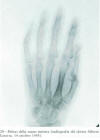 Palm left hand
Palm left hand
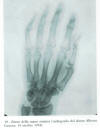 Back left hand
Back left hand
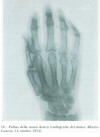 Palm right hand
Palm right hand
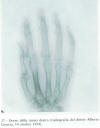 Back right hand
Back right hand
In 1954 Padre Pio had not been feeling well, with
respiratory problems. Prof. Francesco Lotti testified: “On October 13,
1954, with the superior of the convent Padre Carmelo da Sessano, we took
Padre Pio to the radiology department of Casa Sollievo to have an x-ray
of the head and chest done. By disposition of Padre Carmelo, and without
Padre Pio knowing it, we did also radiographs of hands and feet. I was
told by the radiologist that there was absolutely nothing abnormal at
the level of the metacarpal and metatarsal areas.”
(Gerardo, Le Stigmate 1985, 300-3)
(Ger85, Appendice fotografica, 17-21)
Padre Gerardo greeting Padre Pio, and one of his books about the stigmatization of Padre Pio
Regarding the chest wound, Padre Gerardo Di Flumeri has collected 14
descriptions of the direct observations of the examining physicians and
of the friars in contact with Padre Pio. They vary from a linear wound
to one X shaped.[36]
Intigrillo: “The lesion on Padre Pio’s side will always be the subject
of discussion, with regard to both shape and exact position.”[37]
In 1919-1921,Cardinal Augusto Silj, Prefect of Apostolic Signature, the
Supreme Tribunal of the Holy See, visited with Padre Pio several times,
each time expressing a very positive opinion to Pope Benedict XV.[38]
On October 24, 1921, Padre Pio made this drawing of the side wound on a business card of Cardinal Silj.
Cardinal Gasparri
Cardinal Pietro Gasparri
On November 19, 1919, the Cardinal Pietro Gasparri, Secretary of State,
wrote to the superior of the Capuchins, to recommend the Rosi family,
who wanted to confess and receive the Communion from Padre Pio, and also
to ask him to prey for the Pope’s intentions and for his own. He also
asked for some little object from Padre Pio for his niece Antonia Veda.[39]
[40]
[41]
Bishop Costa
Mons. Alberto Costa
In 1919, Mons. Alberto Costa, bishop of Melfi and Rapolla after visiting
with Padre Pio he wrote: “I am convinced of the holiness of Padre Pio.
His life is totally consecrated to the glorification of God and the
conversion of the sinners. My impression can be boiled down to one: to
that of having talked to a saint.”[42]
[43]
On March 24-27, 1920, Archbishop Anselm Edward Kenealy, of Simla, India,
who was himself a Capuchin and a prelate, examined Padre Pio by request
of Pope Benedict XV. Mons. Kenealy was known to be skeptical regarding
mystical phenomena. He spent five hours with Padre Pio.[44]
He reported: “I wanted to see the wounds of Padre Pio because I am
resistant to believe in things if I have not seen them with my own eyes.
I went, I saw, I was conquered (Veni,
Vidi, Victus sum). I am deeply convinced that we have a true saint
here. The Lord, with the five wounds of the Passion has given him great
gifts, and he is completely at ease. If he knows how to suffer, he also
knows how to laugh.”[45]
[46]
[47]
[48]
Mons. Benaventura Cerretti
On May 20, 1920, not completely satisfied, the pope sent archbishop
Bonaventura Cerretti, secretary of the Congregation for Extraordinary
Ecclesiastical Affairs, who’s Prefect was Cardinal Pietro Gasparri, to
examine Padre Pio. He reached the convent on May 24. Padre Onorato wrote
that Cerretti came dressed as a simple priest, showed the letter of the
Holy Office and his episcopal cross, and asked to examine Padre Pio. He
was deeply impressed, wrote in the guest book an expression of
admiration, asked the prayers of Padre Pio, and gave the Pope a very
positive evaluation.[49]
[50]
Mons. Angelo Poli
Mons. Angelo Poli (or Police), apostolic vicar of Allahabad, India,
visited Padre Pio in October 1920. He wrote on November 2, 1920: “I
came, I saw, and I was conquered. Not the slightest doubt remains in me:
the finger of God is here (Digitus
Dei hic est). Seeing Padre Pio one feels overwhelmed by the presence
of supernatural, and at the same time, his natural simple attitude
inspires confidence.”[51]
[52]
[53]
Capuchin missionaries
On February 17, 1921, Padre Pio expressed in a letter to Mons. Poli his
desire to become a missionary: “… I have made persistent pressure on my
director to let me be one of your missionaries, but he finds that I am
unfit for it.”[54]
Padre Besi
On July 12, 1920, Padre Luigi Besi, General Postulator of the Passionists, made an apostolic visitation by disposition of Pope Benedict XV. He went unannounced. When he reached Foggia by train, he was greeted by a Capuchin friar who told him: “Padre Pio has asked for a friar to go to Foggia and pick up a Passionist who had been sent by the Pope. I am here to accompany you to the convent.”[55] [56]
Besi was impressed. He wrote that
Padre Pio “was privileged by God, as
was St. but even more so.” (Gemma
Galgani was Passionist mystic nun who had died about twenty years
before).
[57]
On July 20, 1920 prof. Giuseppe Bastianelli, the physician of pope
Benedict XV was sent personally by him to examine the wounds of Padre
Pio. He visited with Padre Pio on July 22 and examined the wounds. He
gave a favorable report on the supernaturalism of the case.[58]
[59]
In 1920, Mons. Alberto Valbonesi, titular bishop of Memphis, Egypt, a
Vatican employee, visited Padre Pio and was very favorably impressed. He
said that the interview with Padre Pio had ‘compensated me for years of
pain.”[60]
Padre Roberto da Nove
On September 7, 1920, Padre Roberto da Nove di Bassano wrote that he had
been to San Giovanni Rotondo with a skeptical and indifferent attitude,
but after visiting with Padre Pio and closely observing his daily
routine he had been conquered by his serenity and simplicity, and had
dropped all his preventions against him.[61]
Padre Gemelli
Padre Agostino Gemelli
Padre Gemelli
The
afternoon of Sunday April 18, 1920, Padre Agostino Gemelli went to the
convent of San Giovanni Rotondo.
He
was accompanied by Armida Barelli, Padre Benedetto, two priests and the
preacher of the Dioceses of Foggia.
First thing, he wrote in the Book of Visitors: “Every day we ascertain thet the Franciscan tree produces new fruits and this
is the greatest comfort for whoever gets food and life from this marvelous tree. Fra’ Agostino Gemelli, April 18, 1920.
Sal86, 324
Three or four minutes
“Padre Gemelli came late at night, unexpected, and I accompanied him to
a cell for the night. He didn’t see Padre Pio.
Report to the Holy Office
The evening of April 19, 1920, the same day he had
left the convent, Padre Gemelli wrote a report to Mons. Carlo Perosi,
member of the Holy Office.
The complete report of Padre Gemelli is reported in Gerardo di Flumeri,
Il Beato Padre Pio da Pietrelcina, San Giovanni Rotondo 2001,
pp. 421-4
“I
have approached Padre Pio, without any intention of studying him, and
without doing any medical examination….
“However, given the nature of my studies, I could ascertain some facts…
“Based on the existence of these facts, I think that the intervention of
the ecclesiastical authority would be very appropriate…
“I
have been among the ones that have demonstrated that medicine has
nothing to say in the field of the mystical phenomena.
“Only psychological methods can distinguish the true from the false
cases of mysticism…
“Padre Pio is a man of elevated religious life. He is an exemplay man…
“After introducing myself, I engaged him in a conversation that, without
him realizing it, was a psychiatric interrogation...
“Padre Pio doesn’t show the signs of the mental illnesses that have a
religious content. But Padre Pio doesn’t show either any of the
characteristic elements of a mystical life.
“He
seems a man with a restrict field of conscience, lowered psychical
tension, monotonous ideation, abulia...
“The abovementioned Padre has on the palm and on the back of his hands
some round sores with scabs and bleeding.
“I
know that he has similar sores on his feet, and one, in the form of an
upside down cross on the left side of the chest.
“In
the whole it seems to me a case of suggestion unconsciously produced by
Padre Benedetto Nardella, in a sick subject like Padre Pio is.
“This has produced the characteristic manifestations of psittacism,
proper of the structure of hysteria.
“This is only an impression and interpretation
that requires the proof of rigorous and accurate examinations.
Psittacism in Webster dictionary: “Automatic speech without thought of
the meaning of the words spoken.” Like a parrot speaking human words
without any knowledge or their meaning. (Wikipedia).
Gemelli wrote on “Vita e Pensiero” in 1924:
“Psittacism means that the sick person produces the sores with artificial means. The proof is in the fact that they are sores,
more or less deep, but never beyond the subcutaneous tissue. Periodically they deepen more, and bleed. Many of the
presumed cases of stigmatization are vulgar cases of hysteria, where psittacism shows with the imitation of the wounds of
Jesus.”
Gemelli continues in the report to Mons. Perosi: “I suggest removing for
some time Padre Pio from the artificial environment where he is, and
submit him to a rigorous scientific examination.
“I insist on the need to apply the very latest methods of experimental psychology, because they only give us a secure
method to distinguish the true mystical fact from
others that are of psychopathic nature.”
Second report to the Holy Office
After reading the report, the Holy Office asked Padre Gemelli what
measures he suggested.
He
sent a second report on July 2, 1920.
Giovanni Rotondo 2001, pp. 426-7
“Given the impossibility of removing Padre Pio from his environment,
institute a committee of experts consisting of a theologian, a
psychologist and a medical doctor.
Examine Padre Pio’s cell, with all the stuff that he has, and the stuff
that he receives from outside. Remove access to medications.
Put
a cast on an upper limb and a lower limb, to give time to produce
cicatrization. Do a microscopic examination of the coloring substance
dashing the palm of the hand.
Control rigorously food intake and vomiting.
Determine the origin of the perfume. Do an accurate neurological exam.”
Dr. Festa’s reaction
Dr. Giorgio Festa reacted to statements by Padre Gemelli writing on April 7, 1925, a 72 pages relation to the Holy Office,
to demonstrate “the wrongfulness of the
assumptions of Padre Gemelli.”
“Padre Gemelli did not examine the wounds. He had
only a very brief conversation with Padre Pio that lasted few moments….
“Padre Gemelli sentenced “a priory” without knowing anything about Padre Pio’s wounds, and without any most
elementary psychological research….
“When I presented him the real situation Padre Gemelli appeared impressed and moved, and asked for another meeting
between us…
“However after several months this meeting has never happened and he keeps sentencing without having examined and
studied….
“He puts over the garments of a priest, the more
pompous clothes of a medical doctor and scientist. …
“Padre Gemelli had judged Padre Pio not according
to science, but following his own imagination….
Gemelli’s third relation to the
Holy Office
The
Holy office sent the Festa’s report to Padre Gemelli, asking for his
opinion. Padre Gemelli sent his report to the Holy Office on April
6, 1926.
The complete third report of Padre Gemelli is reported in Gerardo di
Flumeri, Il Beato Padre Pio da Pietrelcina, San Giovanni Rotondo 2001,
pp. 428-438
“In
1919 I went to the convent of San Giovanni Rotondo with the secretary of
the bishop of Foggia….
“I
stayed two days. I saw Padre Pio several times, and had very long
conversations with him…..
“I
also examined Padre Pio’s wounds. Padre Benedetto showed them to me,
with great complacency, and with some scenic pomp…..
“I
didn’t do a neurological examination, because I wasn’t in the right
setting….
“I
spent a very long time in conversations with Padre Pio and Padre
Benedetto, to collect precious psychological data through a shrewd
questioning….
“Padre Pio opened up with me with great confidence, and gave me precious
elements, so that I was able to make an opinion of him.
“I
was also invited to speak to the population of San Giovanni Rotondo and
I did it, in the presence of the entire town…..
“I showed the friars an attitude like I was convinced, and they gave me as a present some cloths stained with blood, and
also some photographs. Padre Pio himself gave me an autograph that was affectionate in form, but insignificant in
“The wounds have a strange color. I immediately had the suspect that
they were induced with chemicals…..
“The bottom of the wounds is the same as in the auto lesionist soldiers,
who did it with chemicals….
“From examining the wounds in Padre Pio, I have the suspect that they
are self-inflicted…..”
“Padre Pio is a subject of a very limited
intelligence…
"Padre
Pio has the known features of a marked degree of mental deficiency…
"In
him are the best conditions to constitute with Padre Benedetto the
couple master – slave….”
Padre Pio is tranquil, quiet, and obedient not by virtue, but by mental
deficiency….
Padre Pio is a poor man who repeats stereotyped religious sentences….
Padre Pio is a poor sick person who has learned his lesson from his
teacher Padre Benedetto…..
How
could be that such an extraordinary gift like the stigmata be
accompanied by such a spiritual poverty?....
I believe that Padre Pio is a
psychopath.”
Bibliography
Agostino, d. S. (2012). Diario. San
Giovanni Rotondo: Edizioni Padre Pio.
Ago12
Alessando, d. R. (Saint Pio of Pietrelcina. Everybody's Cyrenean).
2010. San Giovanni Rotondo: Edizioni Padre Pio.
Ale10
Allegri, R. (1998). Padre Pio, un santo tra noi. Milano: Edizioni
Mondadori.
All98
Andrea, G. S. (2008). Padre Pio. L'ultimo sospetto. Edizioni
Piemme.
And98
Capuano, P. (2012). Con p. Pio: come in una fiaba. Foggia:
Grafiche Grilli.
Cap12
Casacalenda, P. P. (1978). Le mie memorie intorno a Padre Pio.
San Giovanni Rotondo: Edizioni Padre Pio.
Paol78
Castelli, F. (2011). Padre Pio under investigation. The secret
Vatican files. San Francisco: Ignatius Press.
Cas12
Chiron, Y. (1999). Padre Pio. Una strada di misericordia. Milano:
Figlie di San Paolo.
Chi99
DeLiso, O. (1962). Padre Pio. New York: All Saints Press.
DeL62
Duchess Suzanne, o. S. (1983). Magic of a Mistic. Stories of Padre
Pio. New York: Clarkson N. Potter.
Duc83
Flumeri, G. D. (1995). Le stigmate di Padre Pio, Testimonianze e
relazioni. Edizioni Padre Pio.
Flu95
Giannuzzo, E. (2012). San Pio da Pietrelcina. Il travagliato persorso
della sua vita terrena. Book sprint edizioni.
Gia12
Ingoldsby, M. (1978). Padre Pio. His Life and Mission. Dublin:
Veritas Publications.
Ing78
Malatesta, E. (1999). La vera storia di Padre Pio. Casale
Monferrato: PIEMME.
Mal99
Mortimer Carty, f. C. (1973). Padre Pio the stigmatist. TAN
Books.
Mor73
Napolitano, F. (1978). Padre Pio of Pietrelcina. A brief biography.
San Giovanni Rotondo: Edizioni Padre Pio.
Nap78
Peroni, L. (2002). Padre Pio da Pietrelcina. Borla.
Per02
Pietrelcina, P. P. (2011). Epistolario I Corrispondenza con i
direttori spirituali (1910-1922). San Giovanni Rotondo: Edizioni
Padre Pio.
Epist. I
Pietrelcina, P. P. (2012). Epistolario IV, corrispondenza con diverse
categorie di persone. San Giovanni Rotondo: Edizioni Padre Pio.
Epist IV
Preziuso, G. (2000). The life of Padre Pio between the altar and the
confessional. New York: Alba House.
Pre00
Pronzato, A. (1999). Padre Pio, mistero doloroso. Editore
Gribaudi.
Pro99
Riese, Fernando da (2010). Padre Pio da Pietrelcina crocifisso senza
croce. San Giovanni Roronto: Edizioni Padre Pio.
Fer10
Ruffin, C. B. (1991). Padre Pio: the true story. Huntington,
Indiana: Our Sunday Visitor, Inc.
Ruf91
Schug, J. O. (1987). A Padre Pio Profile. Petersham, MA: St.
Bedès Publications.
Sch87
Winowska, M. (1988). Il vero volto di Padre Pio. Milano: Edizioni
San Paolo.
Win88
[1] Ago12, 341
[2] Gae08, 23-4
[3] Gia12, 140
[4] Paolino, 54-57
[5] Chi99, 125
[6] Ger95, 147-151
[7] Ger95, 147-151
[8] Ger95, 147-151
[9] Ger95, 147-151
[10] Ger95, 147-151
[11] Ger95, 147-151
[12] Fer10, 147-9
[13] Pre00, 112-4
[14] Fer10, 149-52
[15] Gia12, 145-9
[16] Gia12, 149
[17] Ger95, 173-179
[18] Fer10, 153-4
[19] Pre00, 115-6
[20] Ger95, 64
[21] Gia12, 149-50
[22] Gia12, 150
[23] Mor73, 288-92
[24] Ger95, 179-273
[25] Mal99, 347-55
[26] Pre00, 117-8
[27] Fer10, 154-60, 170-1
[28] Fer10, 171
[29] Ger95, 173-179
[30] Win88, 71
[31] Ger95, 173-273
[32] Cap12, 393
[33] Del62, 79-80
[34] Win88, 71
[35] Ger95, tav, 17-20.
[36] Ger95, 10-22
[37] Cas11, 77
[38] Pre00,124
[39] Pre00, 123
[40] Mal99, 316
[41] Nap78,45-6
[42] Ruf91, 179-80
[43] Mal00, 317
[44] Pre00, 119
[45] Gia12, 175-6
[46] All98, 318
[47] Mal00, 319-20
[48] Ger95, 68-9
[49] Pre00, 124
[50] Per02, 283
[51] Epist. IV,39 Note2.
[52] Ale99, 318
[53] Mal00, 318-9
[54] Epist IV, 40
[55] Per01, 263-4
[56] Mal00, 319
[57] Pre00,
124
[58] Ruf91, 179
[59] Chi99, 153-4
[60] Ruf99, 179
[61] Chi99, 154
[62] Sal86, 324
[63] Per02, 276
[64] Cas11, 5
[65] Ruf91, 178
[66] Chi99, 152-3
[67] Pre00, 119-21
[68] Ruf91, 179
[69] Ruf91, 179
